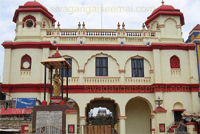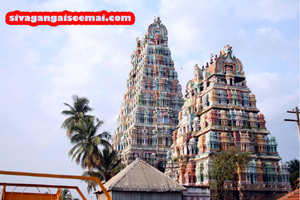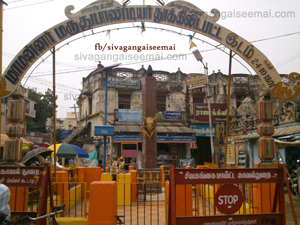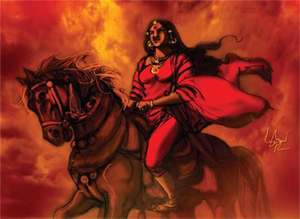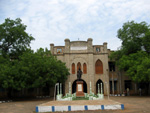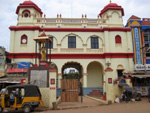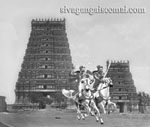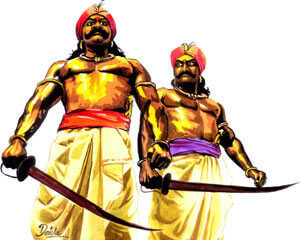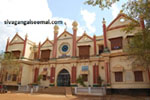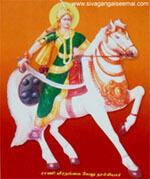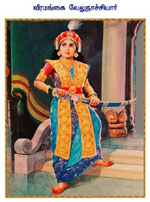Succession dispute in Sivagangai

Sasivarna Peria Oodaya Thevar died in or about the year 1750 and was succeeded by his son Muthuvaduganatha Peria Oodaya Thevar. He, the 2nd Rajah of Sivaganga, was shot dead at Kalaiarkovil in or about the year 1772 in an engagement with the Nawab. He had no male issue, but he left behind him his widow Velu Nachiar and an infant daughter named Vellachi alias Velu Nachiar. The widow Velu Nachiar succeeded her husband in 1780. She took under her protection Padamathoor Gowry Vallaba Thevar, an intelligent lad, and a collateral relation of Sasivarna Thevar, with a view to adopt him as her son and successor. But the two Shervaigars again usurped the Country and contrived to marry the Rani’s daughter Vellachi Nachiar to their favourite Vengam Peria Udaya Thevar and sought several times to put to death Padamathur Gowry Vallabha Thevar.
Vellachi Nachiar, daughter of the Second Rajah of Sivaganga was married to Vengam Peria Oodaya Thevar by the intrigues of the two Marudhu Shervaigars. They knew that Gowry Vallaba Thevar was not only the Padamathoor Poligar, but also a powerful man who had several influential men to protect his interests, and it was proposed that Velu Nachiar should adopt him. They therefore thought that to prevent such an adoption and to effect the above marriage they must put under restraint Gowry Vallaba Thevar and reduce his power and influence; and consequently they imprisoned him at the Kalaiarkoil temple with sufficient guards, and attempted to put him to death.
While he was in prison, Karuppayee, a dancing girl attached to the said temple, pitying his condition, secretly supplied him with food etc and administered to his convenience and comforts. Naturally enough he fell in love with her and kept her as his concubine. She knew that the Shervaigars intended ultimately to put him to death, and therefore contrived to effect his escape. Gowry Vallabha Thevar at last managed to escape and took refuge with Karisaipatty poligar, Vellai Bommai Naick, the Poligar and his Manager, one Sama Iyer alias Shesa Iyer sheltered him at Thuvarankurichi for some months... when this fact was known to the Shervaigars, they demanded the surrender of Gowri Vallaba Thevar from the poligar who being afraid of the Shervaigars powers and influence, sent him to Pudukottai Rajah who gave him refuge at Arunthangi.
When Muthu Vaduga Thevar died, he left behind his wife an infant daughter. Padamattur Oyya Thevar and his father Namasivaya Thevar put forward claims after the death of Muthu Vaduga Thevar. But they incurred the displeasure of the Maruthus. They were forced to flee with Gowri Vallabha Thevar, the brother of Oyya Thevar. Padamattur Oyya Thevar, Poligar of Padamattur had to leave his palayam to Tondaiman of Pudukkottai. Gowri Vallabha fled to Arantangi in Thanjavur where he lived with a concubine Though the Maruthus did not like Gowri Vallabha Thevar who was adopted by Velunachi as her successor. He was long regarded as the destined husband of the heiress of Sivagangai. He was believed by the people of Sivagangai as the settled and rightful successor. But the Maruthus contrived to marry Vellachi to their favourite Vengum Peria Udaya Thevar. Having been outshined by the Maruthu brothers, Vengum Peria Udaya Thevar remained as a mere figure – head.
In or about A.D. 1793 Vellachi died with her infant daughter In A.D. 1796 after three years of her daughter’s death, Velu Nachiyar also passed away. With the view to keep the real power in the country in their hands, Vellai Maruthu’s daughter Maruthathal was married to Vengum Periya Udaya Thevar. Thus the line of Sasivarna Thevar, the first Rajah of Sivagangai became extinct. The Collector of Dindigul in his letter dated 3rd Aug 1789 issued strict instructions to the Shervogar of Shivagunga to restore the stolen property. The Board informed the Collector of Madura on 5th Feb 1792 a complaint received from Tondaiman regarding a dispute which resulted in the loss of one of his servants and 4 or 5 others wounded. The Board asked the Collector to interfere and preserve the peace of the country by using force if necessay. The Collector of Madura submitted an interim report on 11th Feb 1792 the question of the dispute between Tondaiman and Chinna Murdo. He stated that to prevent hostilities between the parties, he had posted a company of revenue sepoys, and he added that the matter would be carefully enquired into and settled.
Kattabomman, Thondaiman and Maruthu
The Board asked the Collector to advise the Raja to desist from disturbing the peace of the country. The Collector wrote on 8 th August 1792 to the brother of Sivaganga Poligar to leave his residence at Ramnad immediately and to proceed to his own District with his family and people with all haste. The Assistant Collector of Dindigul on 20 th Nov 1799 requested the Collector of Ramnad to order the Poligar of Shevagunga not to interfere in the affairs of the Nuttam Palaiyam as he had lately done in the sucession The Assistant Colletor of Ramnad on 28th Nov 1799 to the Assistant Collector of Dindigul stated that he had again ordered the Sherogar of Shevagunga to restore the cattle and desist from Interfering in the succession of the Nuttam Palaiyam. The Collector of Ramnad wrote a letter about Chinna Murdoo’s misconduct. He in his letter dated 15th June 1800 asked the names of the Principal Ministers and writers of Chinna Murdoo in order to bring home to him the charge of having corresponded with Doondiah, the rebel. An Enquiry was instituted against Sherogar's misconduct. Later the Collector informed that the complainants did not turn up for Enquiry.
In the meantime Kattabomman was seized from the jungles of Kalpore in Pudukkottai and handed over to the English by the Tondaiman. On the 16 th of October, Bannerman brought the rebel - chief to an assembly of the poligars at Kayattar and sentenced him to capital punishment. While the numerous chiefs witnessed the whole scene in silent awe and astonishment, Kattabomman was taken to a conspicuous spot and executed Bannerman, after administering a warning that no rank of the people would escape from deterrent punishment if they acted in contempt of British authority, dismissed the assembly The Madras Council condemned the relatives of Kattabomman to perpetual imprisonment and shut them in the fort of Palayamkottai. They were kept in irons and strictly guarded. Three of them died in ordeal while others escaped, among whom were Shevitiah and Kumaraswamy Nayak, the brothers of Kattabomman. It was by a clevar stratagem of Vella Murdoo that the rebels made their dramatic escape. Kumarasamy Nayak, well known as Umathurai, entered into a secret correspondence with the rebels of Panchalamkurichi. Pottipakadai, a servant employed for the collection of firewood, took the letters written on palmyra leaves to and from the prisoners. In 1799 upon the suppression of the Tirunelveli League, the English threw into confinement at Palayamkottai seventeen of the defiant leaders. State prisoners of consequence, they were kept in irons in a small enclosure inside the fort. Two sentinels, who stood inside this enclosure, and a third at its gate kept a constant vigil over their movements, while the garrison maintained a strict check on the ramparts. In the course of their captivity, that lasted for fiteen months, two of the prisoners died; among the survivors were Sevatiah and Oamathurai, the brothers of Kattabomman .
The confederates made repeated efforts to work out the escape of the prisoners. An early attempt was made by Marudu Pandyan, when he despatched his agents to Tirunelveli but they were apprehended and executed. Subsequently the rebels of Panjalamkurichi appealed to Gopala Nayak. The rebel diplomat offered no specific aid immediately, yet agreed to shelter the prisoners if they made their escape and reached Dindugul. In reply to their appeal for assistance, he sent a message; “Let them effect their escape and come to my Hills - they are very welcome here - they can remain here in safety for ten years and shall participate. with me in what I can afford, but cautioned them to be” very careful in avoiding dangers in the road as all the country between Palayamkottai and Veeraptchy (Virupakshi) was under the Company’s government.” After the formation of the rebel confederacy, the leaders bestowed more positive attention on the issue, as the success of the design seemed a real necessity for the destruction to make a surprise assault on Palayamkottai for releasing the prisoners. A probe was made late in 1800 but it was reported that the prisoners were afflicted with smallpox. Therefore the venture was postponed. It is not possible to ascertain who formulated the strategem aimed at the liberation of the prisoners. It represented an imaginative scheme which was carried into effect with a resolution that was equalled only by the daring of its conception. The history of India seldom presents so thrilling an episode. Late in 1800 the insurgents, establishing their base of operation somewhere in Panjalamkurichi opened a secret correspondence with the imprisoned at Palayamkotai. The captives, having been directed to subsist on their own resources, employed servants to cook food. Pottipakada, one of these servants frequented to the nearby jungle to gather firewoood. Requested by the rebels, he served as the agent of correspondence, transmitting verbal messages and at times carrying palm-leaf letters,kept hidden in his foot ware. Through his instrumentality the two sides took each other into confidence for the successful implementation of the plan of action.
In January 1801 when the different provinces drifted into rebellion, the insurgents, 200 in number, led by Pandyan Sherogar and Gidivetti Nayak, started from Panjalamkurichi. To excite no suspicion with the enemy or its agents the veterans had disguised themselves as pilgrims, going to the sacred Temple of Tiruchendur clad in yellow robes playing Kavadi * chanting manthrams, blowing the conch shell, distributing the holy ash and receiving offerings from the votaries, they reached Palayamkottai. The procession wended through the streets around the fort. On listening to the chanting of spells, the prisoners to their great relief whispered each other that the relieving party had really arrived. Before long the “pilgrims” dispersed and vanished. A few days later they re-appeared in the town as hawkers, carrying loads of firewood, plantain leaves and fruits. The local inhabitants approached them for purchases but so exorbitant were the prices, they demanded, that all were dissuaded. With all their loads unsold, the hawkers moved to the street of the fort, shouting aloud “firwood “plantain leaves and “fruits” The sepoys of the fort wanted to make purchases but turned away on learning the prohibitive prices. * Kavadi is the wooden frame carrying the image of Lord Subramaniar and taken on the shoulders of devotees. The devotees normally move in groups taking any route, which they like, before they reach the temple. Everything proceeded according to the predetermined plan. In anticipation of the arrival of the "hawkers" Sevatiah gained the sympathy of the wife of the Superintendent of the Fort and implored her to obtain permission to them for the performance of the ceremonies for the dead. He represented that being in prison he could not perform them for long and promised to do them with fetters on his feet. As he himself admitted subsequently, this white lady showed consideration and extended her assistance. At her intervention the Superintendent of the Fort granted the request and permitted the prisoners to purchase firewood plantain leaves and fruits for the contemplated celebration on a grand scale The prisoners having agreed to buy them at the high prices, as were demanded, the Innocent - looking hawkers entered the fort and walked towards the enclosure of captivity, evoking no suspicion. In the meantime the women belonging to the prisoners and permitted to stay at liberty inside the fort were sent away . Large parties of armed men with the consent and connivance of the residents of the town lay in wait with a few horses to assist in the escape and escort their leaders. Hundreds of them approached silently within a short distance of the south gate of the fort .
At the appointed hour, soon after sun set, on the 2nd of February, Sevatiah gave the signal for escape. Immediately, the hawkers, equipped themselves with the weapons, which they kept concealed in the loads, sprang forward. They overpowered the sentinels at the enclosure, seized the fire arms and carried off the prisoners with fetters on their feet with lightning speed. The enactment of the entire exploit, a major feat indeed, appeared so dramatic and the warhoop raised by them spread so great an alarm that the garrison was taken by complete surprise. All the veterans rushed to the Travancore Gate of the fort, disarmed more of the guards, seized their weapons and got safely off to their supporters who were waiting impatiently with horses to escort their heroes At this crucial moment the European community at Palayamkottai, about twenty men and women were dining or dancing at the Garden House of Macaulay, protected by a single guard and the main British detachment had been cantoned at Sankaranainarkoil, about thirty miles to the westward This remarkable exploit executed with no blood - shed, excited intense popular excitement. It altered drastically overnight, the political situation of the South. It symbolised the triumph of a confederate strategy, unique in the annals of this insurrection. S.R. Lushington, the Collector of Ramnad, rightly reported to the Board of Revenue that the escape was effected “ in consequence of a general confederacy and preconcerted plan” He asserted that the execution of the design was no less daring than rapid and that the sudden attack from the most unexpected quarter together with the warhoop raised by the veterans had deprived the guards of all reflection.
At a secure distance from the fort the rebels halted for a while, put themselves in order and joined by thousands of armed men, pushed immediately to the Valnad Hills, a rugged terrain with thorny bushses in the eastern part of Tirunelveli For a time the liberated leaders appeared undecided where to proceed, whether to Panchalamkurichi or Dindigul, but so spontaneous and extensive was the popular enthusiasm that their escape excited against alien imperialism that it compelled them to stay on in Tirunelveli to spearhead the movement -76 Now advance parties moved in all directions, surprising and reducing the British posts. Instantly the entire country was in open rebellion and the Madras administration expressed its concern that it would be necessary “ to make extra-ordinary exertions for augmenting the force in the Southern Division. From Valnad Hills the insurrection spread, the rebel’s sweft off the military posts set up by the Company and completely annihilated its authority in Panjalamkurichi. They proclaimed Shevitiah as their chief and summoned the inhabitants to join their ranks . Responding cheerfully, the people revolted to their leaders. They reconstructed the demolished fort with mud sand and husk and put it in a defensible state.
The rebellion gained strength when large sections of the population rallied to the support of their leaders. The servants of the Nawab and the inhabitants of the Circar territories joined it as the promoters of the rising Large groups of Maravas, Nadars and Totiens joined the rebel ranks. The Paravas of the coast assisted the rebels by supplying wall pieces, guns and powder. These developments imparted a substantially popular character to the movement. The great leader of the rebellion was Umathurai, a deaf and dumb man and brother of Kattabomman. "I ever know a near relation of Kattabomia Naig, who was both deaf and dumb, was well known by the English under the appellation of Dumby or the Dumb brother by the Musselmans as Mookah and by the Hindoos as Oomee all having the like signification. He was a tall, slender lad of a very sickly appearance, yet possessing that energy of mind which in troubled times, always gains pre- eminence; whilst in his case the very defect which would have impeded another proved a powerful auxiliary in the minds of ignorant and superstitious idolaters. The Oomee was adored; his slightest sign was an oracle and every man flew to execute whatever he commanded No council assembled at which he did not preside; during adventure was undertaken; which he did not lead. His method of representing the English was extremely simple: he collected a few little pieces of straw arranged them on the palm of his left hand to represent the English force; then with other signs, for the time etc, he drew the other hand across and swept them off with a wizzing sound from his mouth which was the signal for attack and he was generally the foremost in executing those plans for our annihilation. Whatever undisciplined valour could effect, was sure to be achieved wherever he appeared; though poor Oomee was atlast doomed to grace a gallows in reward for the most disinterested and purest patiriotism.
He had escaped, as it were,by miracle, in every previous engagement, although every soldier in our camp has most anxious to destroy so notorious and celebrated chieftain. On the 24 th of May when the forst was wrenched from them and the whole were retreating, pursued by our cavalry, poor Oomee fell covered with wounds near a small village about three miles from Punchallacoorchy as soon as our troops had returned from the pursuit. Colonel Agnew instantly ordered the Eteapooreans to follow them till night, offering rewards for only men of consequence dead or alive. Our allies consequently set out with great glee, somewhat late in the evening and in the meantime appearance of quiet induced some women of the village to proceed to the field of carnage, in the hope of finding some of the sufferers capable of receiving succour. Amongst the death of slain they discovered the son of one of the party still breathing and after weeping over him they began to raise him up, when exerting his little remaining strength, he exclaimed” Oh, mother, let me die, but try to save the life of Swamy, who lies wounded near me” the word he used, fully justifies my assertion of their adoration, as its literal meaning is deity. The women animated by the same feelings, immediately obeyed her dying son, and speedily found Oomee, weltering in his blood, but still alive; and those extraordinary matrons immediately lifted, and carried him to the mother’s house where they were busily employed stanching his wounds, when they were alarmed by a sudden shout from the Eteapooreans in pursuit. There is nothing like the ingenuity of woman at such crisis.
These miserable and apparently half-imbecilo creatures conceived a plan in an instant, which not only proved successful, but most probably saved the lives of several others. They covered the body over with a cloth and set up a shrink of lamentation peculiar to the circumstances. The Eteapoooreans on their arrival demanded the cause, and being informed, that a poor lad had just expired of the small - pox, fled for their lives out of the village without turning to look behind them. How he was afterwards reserved, I could never learn but certainly he was present and is active as usual on the 7 th and 10 th of June and was taken alive at the conclusion of the campaign, and hanged along with his gallant and ill fated relation on the tower we had erected in the plain before Panjallumcoorcy now the only monument of that once- dreaded fortress, if we expect the burying ground of six or seven hundred of our slaughtered comrades in its vicinity As he understood the inferiority of poligar- warfare, he employed guerilla tactics. The history of the rebellion is full of such episodes. A believer in mass movement against the English, he sought to win the cooperation of the different sections of people, but did not succeed in winning the support of all. Still, he took no retaliatory measures on individuals; for he permitted the English officers at Tutukudi to go off in safety and generously granted full liberty to Macaulay’s troops after their discomfiture at Panjalamkurichi. His qualities made James Welsh to pay a glowing tribute that: "He was one of the most extraordinary mortals I ever knew" The Collector submitted a report to the Board on 22 nd March 1801 that Milapon with his bandits had made a second incursion from Sivaganga into Ramnad but he was reported to have again taken shelter in Sivaganga notwithstanding any letters to the Sherogars of Sivaganga on the subject of his presumption and folly in provoking the Company’s displeasure. The Collector wrote a letter to the Sherogar of Sivaganga on 23rd March 1801 that Milapon had again found in an asylum in Sivaganga and the seizure and surrender of him and his adherents was demanded of the Sherogar. Either the favour or the resentment of Government would be measured towards Sivaganga according to his conduct.
The Collector wrote a letter to the Sherogar, Sivaganga on 18th April 1801 that the armed peons employed by Sivaganga not satisfied with depredations had also become Murderers. In May 1801 the rebellion spread from Tirunelveli to the Marawa states. The leaders of the rebellion were Vellai Marudu and his more influential younger brother Chinna Marudu, who had already been allied to the rebels of Tirunelveli. Uniting themselves with every rebellious chief and drawing together all the inhabitants of their districts, they assembled a formidable force with grim determination they withdrew from the villages and trusted themselves entirely on the jungle recesses. The temple at Kalayarkoil in the heart of Sivaganga forest became the rallying centre of the rebels, obviously because they attached a religious significance to their struggle. Before their withdrawal they destroyed the villages and forts to prevent them from being used by the British troops .
The rebellion assumed formidable proportions when the insurgents who had been driven from other quarters with loss and discomfiture rallied to Sivaganga On the 28 th of May Umathurai, with his wounds still unhealed, joined the rebels of the Marawars at Kamudi. When Umathurai reached Kamudi, Chinna Marudu took him to Siruvayal, his capital, and attended solicitously upon his welfare. The women of the Marudus distributed sundry articles in charity seeking the mercy of gods for the safety of the Dumby Panchalamkurichi was captured on 22nd of May 1801 and on capture of the fort, the rebels fled to Sivagangai, then ruled by the Marudus who had an army of 20,000 men armed with muskets, matchlocks or spears. Palankeens were taken in procession with the sound of music and waving of light (ARATI) to Siruvayal, when they were lodged in the house of the mother of Marudus. Oomathurai had been afflicted with six desperate wounds. Yet on the third day it seemed certain that he was out of danger. On the 28 th of May with his wounds still unhealed, he reached Kumudi. Marudu Pandyan accompanied by a large crowd of people, reached Kumudi and affectionately welcomed into his camp the hero who returned from the fallen. Taking Ommathurai to his Headquarters at Siruvayal, he attended on him with the greatest care. The villagers even from the remote places visited their gallant leader and gave him presents. The women of the town collected sundry articles, distributed them among the poor, and made offerings to the deities for the quick recovery of the afflicted rebel.
The patriots fleeing from the south and north made the jungle of Kalayarkoil their rallying centre. More of the Inhabitants of Sivaganga and Ramnad joining the insurrection swelled the rebel ranks. The preparations made in the woods and the movements of armed groups portended the possibility of a major offensive against the British positions. Concerned at these, the Company directed its army to take the field against the rebel concentrations in the forests of Sivaganga. However as the odds appeared heavy, Agnew, who commanded the operations, sought the aid of the princes and to sow the seeds of discord in the rebel ranks. At his request the Rajahs of Travancore and Pudukkottai and the Poligar of Ettayapuram sent more of their troops to reinforce the Company’s army, furnished provisions and transmitted intellignece gathered by their hircarrahs. The Collector wrote a letter on 22nd May 1801 to Col Agnew about the attack on Pallimurrae. The sons of the Sherogar headed a party of 1000 peons and attacked Pallimurrae. Particulars of that rebellion had been sent to Lt. Col Agnew.
The Assistant Collector in his letter dated 25 th May 1801 stated that four of Murdoo’s men were seized by Vannni Thevan with the assistance of Inhabitants and that the whole party of Murdoo’s men would be dispelled soon. The Collector wrote a letter on 29th May 1801 about the distrubance in collection in Sivaganga. The fugitive of poligar of Panjalamkurichi arrived with 30 attendants on the morning of 25 and joined the Sherogar’s sons who were employed in blockade of the Palace. The Sherogar had dared to send Amildars into all the Taluks of Ramnad with the exception of the cusba to take charge of the country and consequently the collections of the province had been disturbed. The arrival of Col Agnew’s detachment would restore the confidence of the people and facilitate the collection. A letter dated 1st June 1801 was sent to the Officer Commanding Southern Detachment. The Genealogy of the Zamindar was traced from 1 st Zamindar down to the present one. The two sons of the last widow were placed in charge of lesser Marawas and no measures were taken either to disarm or mortify the spirit of rebellion in the poligars.
Sivaganga Tourist Places
By fb/Sivagangaiseemai Team / August 28, 2014Kalayarkoil Temple Photos
By Muthukumaran / September 1, 2014Quick Links
Maruthu Pandiyar History in Tamil
Read Maruthupandiyar History in Tamil...
Velu Nachiyar History in Tamil
Velu Nachiyar History in Tamil...
Sivagangai Palace
Sivagangai Palace photo gallery to view Read More ......
Sivagangai Car Festival
Sivaganga Photo Gallery
2008 - www.sivagangaiseemai.com
ALL Rights Reserved. Privacy Policy

